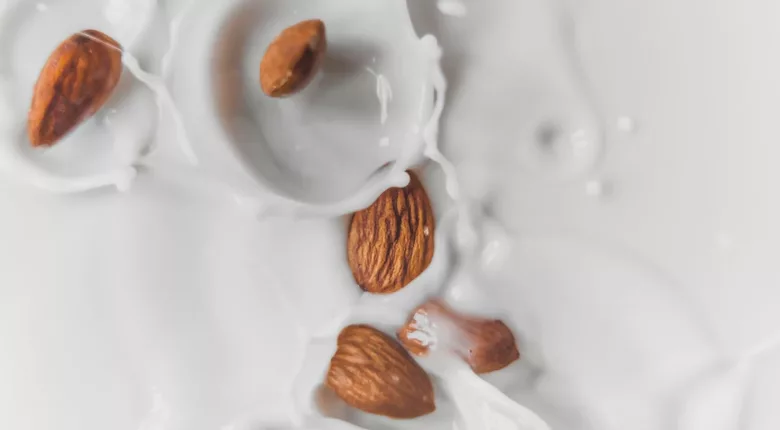Study Shows High Proportion of Spore-Forming Microbes in Plant-Based Dairy Ingredients

Image credit: Austin Wilcox via Unsplash
A recent study by scientists from NIZO Food Research and Wageningen University and Research (WUR) has provided an overview of the levels and types of microbial contaminants present in 88 different plant-based ingredients used to make dairy alternatives. The researchers found the microbial loads in different ingredients to be highly variable, as well as a high proportion of spore-forming microbes among the total microbial counts in many samples.
Overall, the findings show that the starting concentrations and types of microbial contaminants present in plant-based ingredients, even of the same type, can be influenced by many factors, most of which are difficult to control.
The study was conducted to provide a better understanding of microorganisms that are present in various plant-based ingredients to inform microbial risk assessments and strategies for mitigating microbial hazards and spoilage risks throughout the plant-based food production chain. The researchers focused on spore-forming bacteria Bacillus and Clostridium due to their difficulty to remove from ingredients and food manufacturing facilities. Additionally, Bacillus are often found in foods of plant origin.
Although the plant-based ingredients examined in the study are not novel, the reformulation of traditional products with new plant ingredients or alterations of processing conditions for known ingredients requires careful consideration with respect to the microbiological safety and stability of recipes. To mitigate contamination by spore-forming microbes, food manufacturers use various inactivation and food preservation strategies; however, heat treatment to remove spores or fermentation to prevent growth of spoilage organisms may not be suitable for plant-based dairy alternatives. Considering that most of the dairy alternatives made with plant protein-based ingredients undergo at least pasteurization, in addition to the total viable count, it is important to know what spore-forming microorganisms and at what levels are present in raw material.
Samples of commercially available ingredients were provided by producers of plant-based dairy alternatives for the study. Ingredients analyzed included samples of pulses (e.g., pea, faba bean, chickpea, and mung bean), cereals/pseudocereals (e.g., oat, rice, amaranth, and quinoa) and drupes (e.g., coconut, almond, and cashew). Depending on the ingredient type, samples were obtained from 4–12 different suppliers. Samples originated from different geographical locations, specifically, Europe, the Americas, and Asia.
The samples were analyzed for microbial total viable count (TVC), total aerobic mesophilic spore count (TMS), heat resistant aerobic thermophilic spore count (HRTS), anaerobic sulfite reducing Clostridium spore count (SRCS), and Bacillus cereus spore count (BCES).
Many of the ingredients showed a high proportion of spores as part of their total aerobic mesophilic counts. In 63 percent of the samples, the difference between TVC and TMS counts was 1 Log10 unit or less, especially for the majority of pea isolates and concentrates, faba bean isolates, oat kernels and flakes, and for the single samples of chickpea isolate, almond, amaranth, rice, quinoa, and coconut flours. Concentrations of TVC ranged between less than 1 and 5.3 Log10 colony forming units per gram (CFU/g) in different samples, and TMS varied between less than 1 and 4.1 Log10 CFU/g. Levels of HTRS, BCES, and SRCS were generally low, typically around or below the limit of detection of 1 Log10 CFU/g.
Looking for quick answers on food safety topics?
Try Ask FSM, our new smart AI search tool.
Ask FSM →
In total, 845 individual bacterial colonies were isolated belonging to 33 different genera. Bacillus licheniformis and B. cereus group strains were most frequently detected among Bacillus isolates, originating primarily from pea and oat samples. Geobacillus stearothermophilus was the main species encountered as part of HRTS. Among the Clostridium isolates, Clostridum sporogenes/tepidum were predominant species, which were mostly found in pea and almond samples.
Strains with potential to cause foodborne infection or intoxication were typed using the PCR-based method for toxin genes detection. In the B. cereus group, 9 percent of isolates contained the ces gene, 28 percent contained hbl, 42 percent had cytK, and 69 percent were positive for the nhe gene. Absence of the boNT-A and -B genes was confirmed for all isolated C. sporogenes/tepidum strains. Nearly all (98 percent) B. licheniformis isolates were positive for the lchAA gene.
Overall, individual samples of the same types of ingredients showed large differences in their concentrations of TVC, TMS, HRTS, SRCS, and BCES. This is possibly due to the fact that contamination of ingredients can occur at different points in the production chain, for instance, during cultivation of the crop (influenced by geographical location, weather/climate, or the use of biological pesticides), harvesting, shipment, and storage of crops. The processes used to obtain different forms of ingredients can also influence levels and types of microorganisms encountered. Depending on the ingredient, a large spectrum of microorganisms was initially present in plant-based samples as part of the TVC isolates, with the highest diversity of non-spore formers in pulses.









